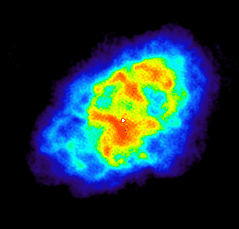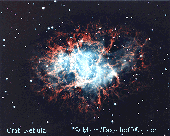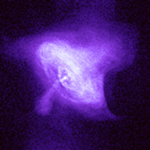Welcome to the World of Multiwavelength
Astronomy!
Until the 20th Century, astronomers learned virtually all they knew about
sources in the sky from only the tiny fraction of
electromagnetic
radiation which is
visible to the eye. However, as astronomers have discovered how to
collect radiation outside this part of the
spectrum, they
have been able to learn much more about the Universe. Many objects reveal
different aspects of their behavior at different
wavelengths.
Other objects are completely invisible at one wavelength yet show up clearly
at another.
The following section explains a little about what is revealed by
observing at each wavelength, and includes an example
image of the Crab
nebula
to illustrate how one source varies its appearance from one wavelength to
another.
The Crab Nebula
In July of 1054 A.D., Chinese astronomers and members of the Anasazi tribe
(native Americans living in present-day Arizona) recorded the appearance of a
new star. Although it was visible for only a few months, it was bright
enough to be seen even during the day!
At the same location in the sky (near the constellation Taurus), the 19th
Century French comet hunter Charles Messier recorded a fuzzy ball of
light which looked similar to a comet, but did not move across the sky.
Messier recorded the nebula, called the Crab for its supposedly crab-like
appearance, as the first object in his catalog (and therefore is sometimes
called M1). It was also one of the first sources of
X-rays identified in
the early 1960s when the first X-ray
astronomy
observations were made (for which it gets another name, Tau X-1).
Scientists now believe the Crab nebula is the remains of a star which
suffered a
supernova
explosion. The core of the star collapsed and formed
a neutron
star which released a tremendous amount of energy, sufficient to blast
the surface layers of the star into space. The expelled gases have formed the
Crab nebula which is still expanding. When the central star collapsed, its
magnetic
fields and rotation collapsed with it, so the neutron star is now a
rapidly rotating object with an intense magnetic field near its surface. The
strobe effect of the rotating star generates pulses observed at
radio, optical,
and X-ray wavelengths. Thus we see flashes from the neutron star each time one
of the magnetic
poles is pointed towards the Earth. Such a neutron star is
called a pulsar.
 |
Radio Astronomy
What the Crab Nebula looks like in the radio can be seen in this image made at the National Radio Astronomy Observatory
(© 1992 (http://heasarc.gsfc.nasa.gov/docs/www_info/credit/nrao.html)). This image shows two
distinctive physical features. First, the colored regions (in this false
colored image, blue is less intense, green is a little more intense, yellow
more intense still, and red the most intense) represent the radio emission
which comes from unbound electrons spiraling around inside the nebula. Second,
the pulsar at the heart of the Crab Nebula generates pulses at radio
frequencies roughly 60 times a second. In this image, the pulsar's flashes are
blurred together (since the image was "exposed" for much longer than
1/60 s) and appears as the bright white spot near the middle of the nebula.
|
Optical Astronomy
The Crab Nebula in the visible spectrum (photograph courtesy of the
Anglo-Australian Observatory) shows two distinct features: a reddish web of
filaments at the outer edges of the nebula and a bluish core.
The blue core of the nebula is from electrons within the nebula being
deflected and accelerated by the magnetic field of the central neutron star.
The radiation appears blue because this process emits more light in the
shorter (bluer) wavelength portion of the visible spectrum than in the longer
(redder) wavelength portion.
The filaments surrounding the edges of the nebula are what is left of the
original outer layers of the star. The red color comes from emission of
hydrogen. Blown off the star by the supernova, the filaments are still
expanding outward into space, away from the central star. Scientists can
measure this expansion by comparing pictures taken several years apart and
tracing the motion of these filaments. Extrapolating backwards in time shows
that the filaments first started expanding away from the center around
1040-1070 A.D. This agrees well with the 1054 A.D. supernova explosion.
|
 |
 |
Ultraviolet Astronomy
The Crab Nebula in the ultraviolet (or UV) shows a nebula which is slightly
larger than what is seen in X-rays (photograph from the Ultraviolet Imaging
Telescope). This reveals that cooler electrons (responsible for the UV
emission) extend out beyond the hot electrons near the central pulsar. This
supports the theory that the central pulsar is responsible for energizing the
electrons. |
X-ray Astronomy
The Crab Nebula in X-rays reveals a condensed core near the central neutron
star. The central star is seen to pulse in X-rays, just like it does at
radio and optical wavelengths.
The Crab Nebula appears smaller and more condensed in X-rays because the
electrons which are primarily responsible for the X-ray emission exist only
near the central pulsar. Scientists believe that the strong magnetic field
near the surface of the neutron star "heats up" the electrons in
it. These "hot" electrons are responsible for the X-ray emission.
|
 |
|
